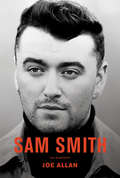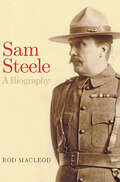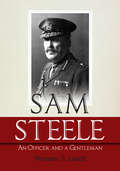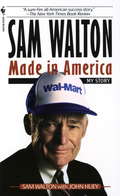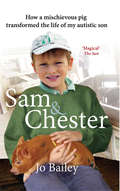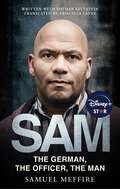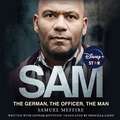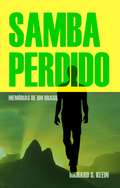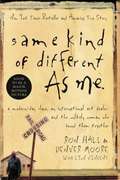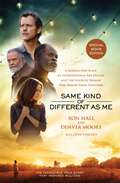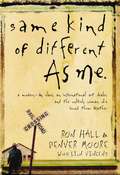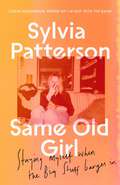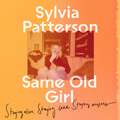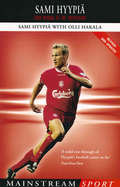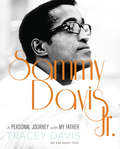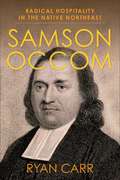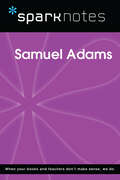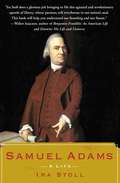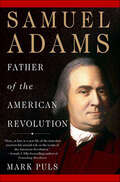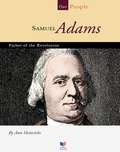- Table View
- List View
Sam Smith E Pub
by Joe AllanSam Smith's debut album, In the Lonely Hour, sold four million copies and won four 2015 Grammy awards. The young, soulful singer has massive crossover appeal, with his album going gold or platinum around the world and his touching honesty about loneliness, love, and his own sexuality coming through in both his music and interviews. While the media largely painted Smith as an "overnight success story," Sam Smith: The Biography shows the hard work that Smith put in for over a decade. Joe Allan is the author of 5 Seconds of Summer: The Unauthorized Biography and Chris Pratt: The Biography.
Sam Smith: The Biography
by Joe AllanSam Smith's debut album, In the Lonely Hour, sold four million copies and won four 2015 Grammy awards. In 2016, he won an Oscar for Best Original Song. The young, soulful singer has massive crossover appeal, with his touching honesty about loneliness, love, and his own sexuality coming through in both his music and interviews. While the media largely painted Smith as an "overnight success story," Sam Smith: The Biography shows the hard work that Smith put in for over a decade.Joe Allan is the author of 5 Seconds of Summer: The Unauthorized Biography and Chris Pratt: The Biography.
Sam Steele: A Biography
by Rod MacleodThe life of Canada&’s police and military hero is &“a story worth telling. Macleod&’s solid research and clear writing also make it a story worth reading&” (AlbertaPrimeTimes.com). Sam Steele, &“the man who tamed the Gold Rush,&” had a high-profile public career, yet his private life has been closely protected. This biography follows Steele&’s rise from farm boy in backwoods Ontario to the much-lauded Major General Sir Samuel Benfield Steele. Drawing on the vast Steele archive at the University of Alberta, this comprehensive biography vividly recounts some of the most significant events of the first fifty years of Canadian Confederation—including the founding of the North-West Mounted Police, the opening of the North through the Klondike, and Canada&’s participation in the South African War—from the perspective of a policeman who became a military leader. Impeccably researched and accessibly written, Sam Steele is perfect for anyone interested in Canada&’s early decades.&“Deeply-researched and elegantly written, this book brings alive one of the most intriguing characters of Canadian history who has been undeservedly forgotten.&” —Charlotte Gray, bestselling author of Murdered Midas &“A revealing story of a talented, dedicated Canadian who always strove to do his best for his country.&” —Canadian Military History&“Focusing on its subject&’s life and career, Sam Steele paints a thoughtful portrait of an interesting and important man that, like any good book, raises interesting and important questions . . . this biography is likely to remain the definitive work on Steele&’s life.&” —Canadian Historical Review
Sam Steele: A Biography
by Rod MacleodThe life of Canada&’s police and military hero is &“a story worth telling. Macleod&’s solid research and clear writing also make it a story worth reading&” (AlbertaPrimeTimes.com). Sam Steele, &“the man who tamed the Gold Rush,&” had a high-profile public career, yet his private life has been closely protected. This biography follows Steele&’s rise from farm boy in backwoods Ontario to the much-lauded Major General Sir Samuel Benfield Steele. Drawing on the vast Steele archive at the University of Alberta, this comprehensive biography vividly recounts some of the most significant events of the first fifty years of Canadian Confederation—including the founding of the North-West Mounted Police, the opening of the North through the Klondike, and Canada&’s participation in the South African War—from the perspective of a policeman who became a military leader. Impeccably researched and accessibly written, Sam Steele is perfect for anyone interested in Canada&’s early decades.&“Deeply-researched and elegantly written, this book brings alive one of the most intriguing characters of Canadian history who has been undeservedly forgotten.&” —Charlotte Gray, bestselling author of Murdered Midas &“A revealing story of a talented, dedicated Canadian who always strove to do his best for his country.&” —Canadian Military History&“Focusing on its subject&’s life and career, Sam Steele paints a thoughtful portrait of an interesting and important man that, like any good book, raises interesting and important questions . . . this biography is likely to remain the definitive work on Steele&’s life.&” —Canadian Historical Review
Sam Steele: An Officer and a Gentleman
by Norman S. LeachA GLOBE AND MAIL BESTSELLER Had there been no Sam Steele, it has been observed, Hollywood would have had to invent him. Born into the comparative stability of the Victorian era's Pax Britannica, Steele lived to witness the postwar turmoil of the Lost Generation. From humble beginnings in what is now Bracebridge, Ontario, to his knighthood in England two years before his death in 1919, Steele's life epitomized the themes of personal adventure, service to crown and country, and the zeal for modernization and social order that characterized nineteenth-century Canada within the British Empire. Steele's long and storied career threaded through many pivotal moments in Canada’s settlement and development history: the Fenian raids, the expansion of law and order (on horseback and sporting red serge) across the North-West Territories, the exile of Sitting Bull into Canada, the construction of the national railway that welded together the nation, Riel's Rebellion, the Klondike Gold Rush and opening of the North, the Boer War, and the Canada's coming of age during the First World War.
Sam Walton
by Sam Walton John HueyMeet a genuine American folk hero cut from the homespun cloth of America's heartland: Sam Walton, who parlayed a single dime store in a hardscrabble cotton town into Wal-Mart, the largest retailer in the world. The undisputed merchant king of the late twentieth century, Sam never lost the common touch. Here, finally, inimitable words. Genuinely modest, but always sure if his ambitions and achievements. Sam shares his thinking in a candid, straight-from-the-shoulder style. In a story rich with anecdotes and the "rules of the road" of both Main Street and Wall Street, Sam Walton chronicles the inspiration, heart, and optimism that propelled him to lasso the American Dream.
Sam and Chester: How a Mischievous Pig Transformed the Life of My Autistic Son
by Jo Bailey-MerrittWhen Sam Bailey-Merritt was just two years old, almost overnight he lost the ability to communicate or function. His mother, Jo, was at a loss as to what to do as she saw her son grow increasingly isolated and begin to suffer from uncontrollable meltdowns. Eventually, Sam was diagnosed with autism.Sam's condition continued to worsen and, just when Jo had all but given up hope of being able to help him, the family went on a day trip to a nearby miniature pig farm. Sam immediately bonded with a tiny ginger piglet called Chester, who stood sad and alone, apart from the rest of the litter. The connection between the boy and the animal was immediate and their unusual friendship blossomed from the moment the family brought Chester home. The tiny pig refused to leave Sam's side - it was as if he knew that Sam needed a friend. And, for the first time in five years, Jo saw her son really laugh.While Sam's confidence grew, Chester grew in a different way: the micro pig that was supposed to become the size of a Cocker Spaniel in fact ballooned to three times that size - with hilarious consequences for the family! Chester has turned Sam's life around. He now has the ability to communicate his feelings, make friends and is caring and kind towards others.Sam and Chester is the heart-warming story of how a teacup-sized ginger pig helped to transform the life of a boy with autism. It is the emotional story of a mother's fight to win back her son.
Sam: Coming soon to Disney Plus as Sam - A Saxon
by Samuel MeffireThe extraordinary and exciting story of East Germany's first Black police officer, coming soon to Disney Plus!Samuel Meffire grew up as a Black German in East Germany and, against all odds, became East Germany's first black police officer. In the nineties, marked by upheaval and unrest, he was the face of an anti-racism campaign, received invitations to politicians' receptions, talk shows and numerous media appearances. But as Europe changed, he slipped from being a model policeman into crime himself, eking out his days as a hunted criminal and prisoner. After seven years in prison, Meffire fought his way back to life and once again went to the front lines of social upheaval, but this time not as a police officer, but as a social worker for young people with a serious history of violence, and as a successful indie author of dystopian crime novels.In his memoir, Samuel Meffire gives an intimate insight into his emotional world. In the background and with an almost brutal frankness, he grippingly recounts his life across several continents and, looking back, gives us a fascinating insight into an overlooked period of history.
Sam: Coming soon to Disney Plus as Sam - A Saxon
by Samuel MeffireThe extraordinary and exciting story of East Germany's first Black police officer, coming soon to Disney Plus!Samuel Meffire grew up as a Black German in East Germany and, against all odds, became East Germany's first black police officer. In the nineties, marked by upheaval and unrest, he was the face of an anti-racism campaign, received invitations to politicians' receptions, talk shows and numerous media appearances. But as Europe changed, he slipped from being a model policeman into crime himself, eking out his days as a hunted criminal and prisoner. After seven years in prison, Meffire fought his way back to life and once again went to the front lines of social upheaval, but this time not as a police officer, but as a social worker for young people with a serious history of violence, and as a successful indie author of dystopian crime novels.In his memoir, Samuel Meffire gives an intimate insight into his emotional world. In the background and with an almost brutal frankness, he grippingly recounts his life across several continents and, looking back, gives us a fascinating insight into an overlooked period of history.(P) 2023 Little Brown Book Group Limited for and on behalf of Dialogue Books
Sam: Coming soon to Disney Plus as Sam - A Saxon
by Samuel MeffireThe extraordinary and exciting story of East Germany's first Black police officer, coming soon to Disney Plus!Samuel Meffire grew up as a Black German in East Germany and, against all odds, became East Germany's first black police officer. In the nineties, marked by upheaval and unrest, he was the face of an anti-racism campaign, received invitations to politicians' receptions, talk shows and numerous media appearances. But as Europe changed, he slipped from being a model policeman into crime himself, eking out his days as a hunted criminal and prisoner. After seven years in prison, Meffire fought his way back to life and once again went to the front lines of social upheaval, but this time not as a police officer, but as a social worker for young people with a serious history of violence, and as a successful indie author of dystopian crime novels.In his memoir, Samuel Meffire gives an intimate insight into his emotional world. In the background and with an almost brutal frankness, he grippingly recounts his life across several continents and, looking back, gives us a fascinating insight into an overlooked period of history.
Samba Perdido
by Richard KleinPassado no colorido Rio de Janeiro, Samba Perdido é um livro instigante de memórias do Brasil. Situado nos anos 1960, 1970 e 1980, o livro fornece um poderoso insight de um período em que o pais lutava para sair de uma ditadura e se descobria como uma sociedade livre e democrática. Em paralelo a esse drama, Samba Perdido narra o caminho do autor em obter sua própria identidade brasileira como filho de imigrantes ingleses imersos na complexidade do país. Richard Klein nasceu no Rio de Janeiro em 1962 – o mesmo ano em que os Rolling Stones e os Beatles gravaram seus primeiros singles e no mesmo ano em que o Brasil ganhou a sua segunda Copa do Mundo de futebol. Seu pais judaico-ingleses, haviam se mudado para um florescente Rio de Janeiro logo após a 2ª Guerra Mundial e prosperaram. Eles nunca, entretanto, se adaptaram totalmente à sua nova terra, – e certamente ao futebol ou ao rock and roll. Richard, no entanto, cresceria para amar ambos. Richard mostra, em primeira mão, a vida, a diversão e os excessos da elite de sua geração privilegiada pelo regime militar. Sob uma ótica ao mesmo tempo estrangeira e nacional, o autor surpreende o leitor com piadas, aventuras, reflexões e fatos, ao mesmo tempo que consegue fornecer uma imersão em uma época maravilhosamente conturbada da história brasileira.
Same Kind of Different As Me
by Ronald E. Hall Denver Moore Lynn VincentA dangerous, homeless drifter who grew up picking cotton in virtual slavery. An upscale art dealer accustomed to the world of Armani and Chanel. A gutsy woman with a stubborn dream. A story so incredible no novelist would dare dream it. It begins outside a burning plantation hut in Louisiana . . . and an East Texas honky-tonk . . . and, without a doubt, in the heart of God. It unfolds in a Hollywood hacienda . . . an upscale New York gallery . . . a downtown dumpster . . . a Texas ranch. Gritty with pain and betrayal and brutality, this true story also shines with an unexpected, life-changing love.
Same Kind of Different As Me Movie Edition: A Modern-Day Slave, an International Art Dealer, and the Unlikely Woman Who Bound Them Together
by Denver Moore Lynn Vincent Ron HallSoon to be a Major Motion Picture A dangerous, homeless drifter who grew up picking cotton in virtual slavery.An upscale art dealer accustomed to the world of Armani and Chanel.A gutsy woman with a stubborn dream.A story so incredible no novelist would dare dream it. It begins outside a burning plantation hut in Louisiana . . . and an East Texas honky-tonk . . . and, without a doubt, inside the heart of God. It unfolds in a Hollywood hacienda . . . an upscale New York gallery . . . a downtown dumpster . . . a Texas ranch.Gritty with betrayal and pain brutality, it also shines with an unexpected, life-changing love.Bonus material in this special movie edition includes:a new epilogue with updates on the authors since the release of the original book;the amazing story behind the movie, how it got made, and the incredible experiences while filming in Jackson, MS;photos from the movie set.
Same Kind of Different As Me: A Modern-Day Slave, an International Art Dealer, and the Unlikely Woman Who Bound Them Together
by Denver Moore Lynn Vincent Ron HallA dangerous, homeless drifter who grew up picking cotton in virtual slavery. An upscale art dealer accustomed to the world of Armani and Chanel. A gutsy woman with a stubborn dream. A story so incredible no novelist would dare dream it. It begins outside a burning plantation hut in Louisiana. . . and an East Texas honky-tonk . . .and, without a doubt, in the heart of God. It unfolds in a Hollywood hacienda . . . an upscale New York gallery . . . a downtown dumpster. . . a Texas ranch. Gritty with pain and betrayal and brutality, it also shines with an unexpected, life-changing love. This incredible retelling now includes an interview with the authors and a reader’s guide that is perfect for individual or group study. The most inspirational and emotionally gripping story of faith, fortitude, and friendship I have ever read. A powerful example of the healing, restorative power of forgiveness and the transformational, life changing power of unconditional love. —Mark Clayman, Executive Producer for the Academy Award–nominated The Pursuit of Happyness Denver Moore and Ron Hall’s story is one that moved me to tears. The friendship that forms between these two men at a time when both were in great need is an inspiration to all of us to be more compassionate to everyone we come in contact with. This is truly a wonderful book! —Mrs. Barbara Bush
Same Old Girl: Staying alive, staying sane, staying myself
by Sylvia Patterson'There's no mistaking the writing of Sylvia Patterson' Sunday Times'One of the finest writers in the world' David QuantickHow does the big stuff in life truly change us?In late 2019, Sylvia Patterson was a celebrated pop journalist, still merrily writing about the musical greats. But with the diagnosis of a life-threatening disease, a global pandemic and the collapse of her industry, life was about to take a drastic turn.It was a misadventure that would teach her many things. The power of friendship, the shock of mortality and what happens when love is tested. How a walk in the park, a spontaneous dance and a TV hero can save your life. How your perspective can shift on everything, from work, family and music, to what truly makes you happy. And what really happens when your body, never mind your kitchen, falls apart.The follow-up to the Costa-shortlisted I'm Not with the Band, this is Sylvia's unflinching, poignant and gallows-funny odyssey through the mid-life trials we all face, as she tries to answer the big question: would it all change her, or would she stay that same old girl?
Same Old Girl: Staying alive, staying sane, staying myself
by Sylvia Patterson'There's no mistaking the writing of Sylvia Patterson' Sunday Times'One of the finest writers in the world' David QuantickHow does the big stuff in life truly change us?In late 2019, Sylvia Patterson was a celebrated pop journalist, still merrily writing about the musical greats. But with the diagnosis of a life-threatening disease, a global pandemic and the collapse of her industry, life was about to take a drastic turn.It was a misadventure that would teach her many things. The power of friendship, the shock of mortality and what happens when love is tested. How a walk in the park, a spontaneous dance and a TV hero can save your life. How your perspective can shift on everything, from work, family and music, to what truly makes you happy. And what really happens when your body, never mind your kitchen, falls apart.The follow-up to the Costa-shortlisted I'm Not with the Band, this is Sylvia's unflinching, poignant and gallows-funny odyssey through the mid-life trials we all face, as she tries to answer the big question: would it all change her, or would she stay that same old girl?
Same Old Girl: Staying alive, staying sane, staying myself
by Sylvia Patterson'There's no mistaking the writing of Sylvia Patterson' Sunday Times'One of the finest writers in the world' David QuantickHow does the big stuff in life truly change us?In late 2019, Sylvia Patterson was a celebrated pop journalist, still merrily writing about the musical greats. But with the diagnosis of a life-threatening disease, a global pandemic and the collapse of her industry, life was about to take a drastic turn.It was a misadventure that would teach her many things. The power of friendship, the shock of mortality and what happens when love is tested. How a walk in the park, a spontaneous dance and a TV hero can save your life. How your perspective can shift on everything, from work, family and music, to what truly makes you happy. And what really happens when your body, never mind your kitchen, falls apart.The follow-up to the Costa-shortlisted I'm Not with the Band, this is Sylvia's unflinching, poignant and gallows-funny odyssey through the mid-life trials we all face, as she tries to answer the big question: would it all change her, or would she stay that same old girl?
Sami Hyypiä: From Voikkaa to the Premiership
by Okki Halala Sami HyypiaWhen Gerard Houllier took over as manager of Liverpool FC in 1999, his quest was to bring glory back to Anfield. His prime concern lay with strengthening his defence and to this end he made what is arguably one of his finest signings. Houllier targeted Sami Hyypiä, a relatively unknown player who was at the time captain of the Dutch team Willem II. This candid biography focuses on Hyypiä's eventful journey from the Finnish village of Voikkaa to the heights of the English Premiership, where he has become the inspirational leader of the Liverpool team. It charts his life from childhood and documents his astonishing rise in the game, from youth teams to Finnish senior sides Pallo-Peikot, KUMU and MyPa - as well as his international career - before moving on to his years in Holland and England playing for Willem II and Liverpool respectively. Hyypia reflects on past games in which he competed against the likes of Batistuta, Rivaldo, Van Nistelrooy and Henry, and recalls the Liverpool derbies in which he's played. He also shares his thoughts on the Reds' 2001 UEFA Cup campaign, in which they defeated the mighty Barcelona in the semi-finals before going on the defeat Deportivo Alavés 5-4 in the final to clinch the coveted trophy. In 2001-02 season, during which the team had to contend with the serious illness of their manager, Hyypiä led them to the quarter-finals of the Champions League and second place in the Premiership. Then, in season 2002-03, Liverpool won the Worthington Cup and narrowly missed out on a Champions League place. Featuring exclusive contributions from numerous former and current colleagues and teammates, including Gérard Houllier, Jari Litmanen and Michael Owen, Sami Hyppiä digs deep to reveal all about the man, his views on the game, and his hopes and plans for the future.
Samidha FYBA - SPPU: समिधा एफ.वाय.बी.ए. - सावित्रीबाई फुले पुणे यूनिवर्सिटी
by Sadhana Amteबाबा आमटे यांच्या लोकविलक्षण जीवनाला साथ देत असताना साधनाबाईंनी अपार कष्ट केले, अग्निदिव्ये म्हणावीत अशा प्रसंगांतून निर्भयपणे वाटचाल केली आणि हे सारे सहजतेने व आनंदाने सोसताना त्यांनी स्वतःच्या स्वतंत्र व्यक्तिमत्त्वाचे वैशिष्ट्यही टिकविले. बाबा आमटे यांचे कार्य किती महान आहे याचे अधिक वर्णन करण्याची आवश्यकता नाही. पण त्याचबरोबर त्यांच्या स्वभावात अद्वितीय सहानुभूती आणि जबरदस्त तापटपणा, असामान्य सहृदयता आणि तत्त्वांचा आग्रह धरताना पत्नीच्या होरपळीकडे त्यांनी काही वेळा केलेली डोळेझाक अशी एक विलक्षण विसंगती आहे. बाबांच्या वादळी जीवनात त्यांना साधनाताईंनी जी आयुष्यभर साथ दिली तिची अद्भुतरम्य कहाणी असे या आत्मकथेचे स्वरूप आहे.
Sammy Davis Jr.: A Personal Journey with My Father
by Tracey Davis Nina Bunche PierceNicknamed Mr. Show Business, Sammy Davis Jr. was a consummate performer who sang, danced, and acted on film, television, radio, and the stage for over six decades.<P><P> In this uniquely intimate volume, the entertainment legendOCOs story comes to life through rare family photos and a compelling narrative based on conversations between Sammy Davis Jr. and his daughter, Tracey Davis. The story of a future superstar unfolds beginning with his bittersweet childhood days, raised primarily by his grandmother in Harlem. On the stage by age three, he first became a star in vaudeville with the Will Mastin Trio. Davis was already an up-and-coming performer by the time he was recruited into the Army during World War II. As Tracey Davis candidly relates, it was there that her father first learned to use his talent?singing and dancing?as a weapon against racial bigotry. DavisOCOs career took off in the 1940s through his sheer determination, talent, and the support of friends like Frank Sinatra. With tenderness and humor Tracey describes her fatherOCOs friendship with Sinatra, and how he stood by him when Davis married TraceyOCOs Swedish actress mother. In a time when interracial marriages were forbidden by law in thirty-one states, both bride and groom endured an onslaught of negative press and even death threats. Complete with rare personal and professional photos, "Sammy Davis Jr. " recounts DavisOCOs adventures through the Rat Pack era, and the extraordinary obstacles he overcame to become a 5OCO6OCO, 120-pound legend who across six decades packed in more than forty albums, seven Broadway shows, twenty-three films, and countless nightclub and concert performances. What emerges from the pages of this loving, but utterly frankly written book, is a uniquely personal perspective on one of the greatest pop culture icons of the twentieth century. "
Samson Occom: Radical Hospitality in the Native Northeast (Religion, Culture, and Public Life #48)
by Ryan CarrThe Mohegan-Brothertown minister Samson Occom (1723–1792) was a prominent political and religious leader of the Indigenous peoples of present-day New York and New England, among whom he is still revered today. An international celebrity in his day, Occom rose to fame as the first Native person to be ordained a minister in the New England colonies. In the 1770s, he helped found the nation of Brothertown, where Coastal Algonquian families seeking respite from colonialism built a new life on land given to them by the Oneida Nation. Occom was a highly productive author, probably the most prolific Native American writer prior to the late nineteenth century. Most of Occom’s writings, however, have been overlooked, partly because many of them are about Christian themes that seem unrelated to Native life.In this groundbreaking book, Ryan Carr argues that Occom’s writings were deeply rooted in Indigenous traditions of hospitality, diplomacy, and openness to strangers. From Occom’s point of view, evangelical Christianity was not a foreign culture; it was a new opportunity to practice his people’s ancestral customs. Carr demonstrates Occom’s originality as a religious thinker, showing how his commitment to Native sovereignty shaped his reading of the Bible. By emphasizing the Native sources of Occom’s evangelicalism, this book offers new ways to understand the relations of Northeast Native traditions to Christianity, colonialism, and Indigenous self-determination.
Samuel Adams (SparkNotes Biography Guide)
by SparkNotesSamuel Adams (SparkNotes Biography Guide) Making the reading experience fun! SparkNotes Biography Guides examine the lives of historical luminaries, from Alexander the Great to Virginia Woolf. Each biography guide includes:An examination of the historical context in which the person lived A summary of the person&’s life and achievements A glossary of important terms, people, and events An in-depth look at the key epochs in the person&’s career Study questions and essay topics A review test Suggestions for further reading Whether you&’re a student of history or just a student cramming for a history exam, SparkNotes Biography guides are a reliable, thorough, and readable resource.
Samuel Adams: A Life
by Ira StollIn this stirring biography, Samuel Adams joins the first tier of founding fathers, a rank he has long deserved. With eloquence equal to that of Thomas Jefferson and Tom Paine, and with a passionate love of God, Adams helped ignite the flame of liberty and made sure it glowed even during the Revolution's darkest hours. He was, as Jefferson later observed, "truly the man of the Revolution." In a role that many Americans have not fully appreciated until now, Adams played a pivotal role in the events leading up to the bloody confrontation with the British. Believing that God had willed a free American nation, he was among the first patriot leaders to call for independence from England. He was ever the man of action: He saw the opportunity to stir things up after the Boston Massacre and helped plan and instigate the Boston Tea Party, though he did not actually participate in it. A fiery newspaper editor, he railed ceaselessly against "taxation without representation." In a relentless blizzard of articles and speeches, Adams, a man of New England, argued the urgency of revolution. When the top British general in America, Thomas Gage, offered a general amnesty in June 1775 to all revolutionaries who would lay down their arms, he excepted only two men, John Hancock and Samuel Adams: These two were destined for the gallows. It was this pair, author Ira Stoll argues, whom the British were pursuing in their fateful march on Lexington and Concord. In the tradition of David McCullough's John Adams, Joseph Ellis's The Founding Brothers, and Walter Isaacson's Benjamin Franklin, Ira Stoll's Samuel Adams vividly re-creates a world of ideas and action, reminding us that none of these men of courage knew what we know today: that they would prevail and make history anew. The idea that especially inspired Adams was religious in nature: He believed that God had intervened on behalf of the United States and would do so as long asits citizens maintained civic virtue. "We shall never be abandoned by Heaven while we act worthy of its aid and protection," Adams insisted. A central thesis of this biography is that religion in large part motivated the founding of America. A gifted young historian and newspaperman, Ira Stoll has written a gripping story about the man who was the revolution's moral conscience. Sure to be discussed widely, this book reminds us who Samuel Adams was, why he has been slighted by history, and why he must be remembered.
Samuel Adams: Father of the American Revolution
by Mark Puls“A brief, sharply focused biography [that] restores Adams to his rightful place as an indispensable provocateur of American liberty” (Kirkus Reviews).Samuel Adams is perhaps the most unheralded and overshadowed of the founding fathers, yet without him there would have been no American Revolution. A genius at devising civil protests and political maneuvers that became a trademark of American politics, Adams astutely forced Britain into coercive military measures that ultimately led to the irreversible split in the empire.Through his remarkable political career, Adams addressed all the major issues concerning America’s decision to become a nation—from the notion of taxation without representation to the Declaration of Independence. George Washington, Thomas Jefferson and John Adams all acknowledged that they built our nation on Samuel Adams’ foundations. Now, in this riveting biography, his story is finally told and his crucial place in American history is fully recognized.Winner of the 2007 Fraunces Tavern Museum Book Award
Samuel Adams: Father of the Revolution
by Ann HeinrichsSamuel Adams is known as the Father of the American Revolution. Young readers will gain insight and knowledge into the buildup to revolution in America and the important role that Samuel Adams played in it and in what came after, the start of a new nation.
